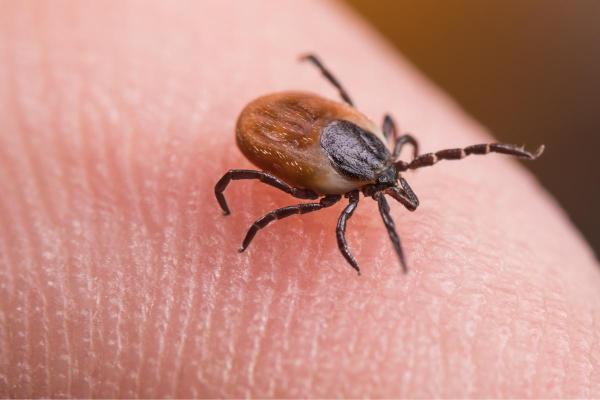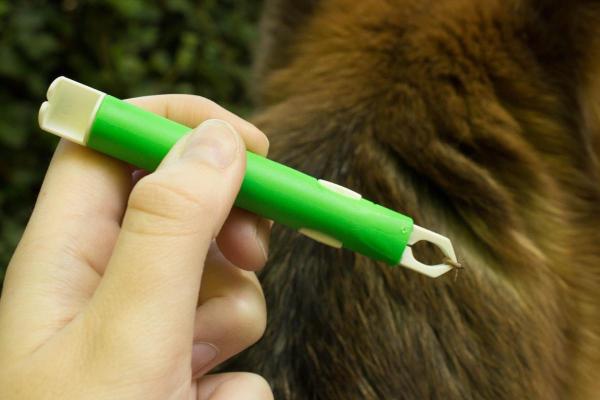My Dog Has Ticks and Sleeps in My Bed



See files for Dogs
While ticks can be present all year round, the arrival of spring means they become more active and prolific. Preventive measures should always be taken, but we need to be extra careful while the temperatures increase. This is especially if we are out walking in the country or in any area with long grass. Ticks spread very harmful diseases such as Lyme disease, babesiosis, ehrlichiosis, anaplasmosis and Q fever, among others. Many of these diseases are zoonotic, meaning they can infect a dog and it can then be spread to humans. Dogs can even be reservoirs for diseases spread by ticks which do not affect them.
This potential for zoonotic disease means we need to be very careful when sharing our space with them. If your dog has ticks and sleeps in your bed, you should be asking can I get them?
If my dog has ticks and sleeps in my bed, can they give them to me?
Ticks are arachnids of the order Ixodida. They are parasitic by nature, meaning they feed on the blood of animals. These animals are most often mammals, including both humans and dogs. This means if a tick is on your dog, they can make the jump to you. Sleeping in the same bed means you are in close proximity and not moving much, the perfect environment for a tick to transfer from your dog to you.
There are several families and almost 900 individual tick species that we know about. Not all of these ticks have the same affinity for biting both humans and dogs. Those that most frequently feed on dogs will differ according to area where you live. These include the American dog tick (Dermacentor variabilis) and deer tick (Ixodes scapularis) in the US and the castor bean tick (Ixodes ricinus) and the ornate cow tick (Dermacentor reticulatus) in Europe. The brown dog tick (Rhipicephalus sanguineus) can be found almost worldwide.
External parasites such as ticks can attach themselves to your dog, usually when they are outside. Ticks like to stay on long grass and transfer to animals as they pass. This is why we need to be very careful when we are walking our dog. Doing a spot check after the walk and before they enter the home is a good idea. Doing so immediately after the walk gives us a better chance of removing the tick before they can pass on any disease.
To learn how to do it effectively and safely, take a look at our article on how to get a tick off a dog.

What happens if a dog with ticks sleeps in my bed?
Ticks have mouthparts called chelicerae which they use to bite and pierce the skin of their hosts. When they do so, they attach themselves so they can take their time when feeding off this host's blood. Males only consume a small amount of blood, but females can remain attached to the skin for several days. They grow larger and take on a whitish and swollen appearance. Once they have consumed enough blood, they release themselves and look for a place to lay their eggs.
The main problem with this cycle is the possibility of disease transmission. While the tick is consuming the blood of its host, there is a possibility it may transmit some disease. These arachnids act as vectors of serious pathologies such as Lyme's disease. This is a disease especially dangerous for humans and causes symptoms such as erythema, fever, headache and fatigue.
When a dog with ticks sleeps in our bed, they can easily move from one host to another. Ticks use their olfactory senses and heat detection to find a host. They may wait in the bedsheets, latching on to us when they detect our warm bodies. While it is unlikely they will lay eggs in the bed, they can lay them elsewhere in the home and create more opportunities for parasitization.
Discover other hematophagous species like the tick with our article on the animals that feed on blood.
How do I know if I've been bitten by a tick?
If we are out walking, we are most likely to get a tick on the leg. This is because ticks wait at the level of their potential host, so they will remain on long grasses which brush against our legs as we walk. When we are lying in bed with a dog infested by ticks, they can attach almost anywhere on our body.
Since ticks inject an anesthetic and blood coagulant into the skin when they bite, you will often not notice they have bitten you until after the fact. If it is a female tick and they are taking their time to feed, you should eventually notice them as they grow larger. When a tick releases themselves, they will leave inflamed and red welts at the bite site.
When the tick has been spotted as they are feeding, you need to be very careful when removing it. Simply pulling it off or trying to kill it with home remedies is not recommended in these cases, as it could promote the release of pathogens into your bloodstream. For those living in areas with a lot of ticks, special tick tweezers are recommended. If you don't know how to remove it safely, see a doctor so he or she can do it.
If the tick is no longer present, you may see a red lesion at the bite site. If this is the case, we recommend you contact a doctor immediately, especially if the lesion is large and has a reddish halo around it like a target. This is indicative of a tick bite that causes Lyme's disease and you may need to be tested.

What do I do if my dog has ticks and sleeps with me?
If you know your dog has ticks, you'll need to keep them out of your bed until you've completely eliminated these parasites to avoid the risk of getting sick.
Ticks can be removed using the aforementioned special tweezers. These prevent the mite from salivating during removal, something which increases the risk of pathogen transmission, i.e. passing on one of the diseases spread from dogs to humans. They also prevent the head from separating from its body, leaving it embedded in the dog's skin.
If you don't know how to remove a tick properly or your dog has many ticks at the same time, it's best not to try to remove them manually and instead go to your veterinarian. They can provide you with an antiparasitic drug for dogs which kills the ticks and makes them safer to remove.
While removing ticks from dogs after they are bitten is important, prevention is always better than cure. Providing protection for your dog from new parasites is an important part of their health plan. Their specific deworming schedule will need to be arranged by the veterinarian, but there are several options you can try that include the following:
- Antiparasitic collars: protect the animal against various types of parasites, including ticks and fleas. They can have an effect that lasts for several months, but this will depend on the product used.
- Antiparasitic pipettes: antiparasitic solution is placed between their shoulder blades which provides protection for an average of 1-3 months. More frequent application may be required at times of the year when ticks are more prolific.
- Antiparasitic pills: these used to kill the parasites once they have bitten the dog and will need to be prescribed by a veterinarian.
During spring and summer, it's advisable to combine several antiparasitic products to increase effectiveness. For example, you may want to use a pipette and a parasite collar at the same time, especially if they are often outside in the country.
To learn more about the dangers of these external parasites for dogs, take a look at our articles explaining the different tick diseases in dogs and the types of tick species.

This article is purely informative. AnimalWised does not have the authority to prescribe any veterinary treatment or create a diagnosis. We invite you to take your pet to the veterinarian if they are suffering from any condition or pain.
If you want to read similar articles to My Dog Has Ticks and Sleeps in My Bed, we recommend you visit our De-worming category.







